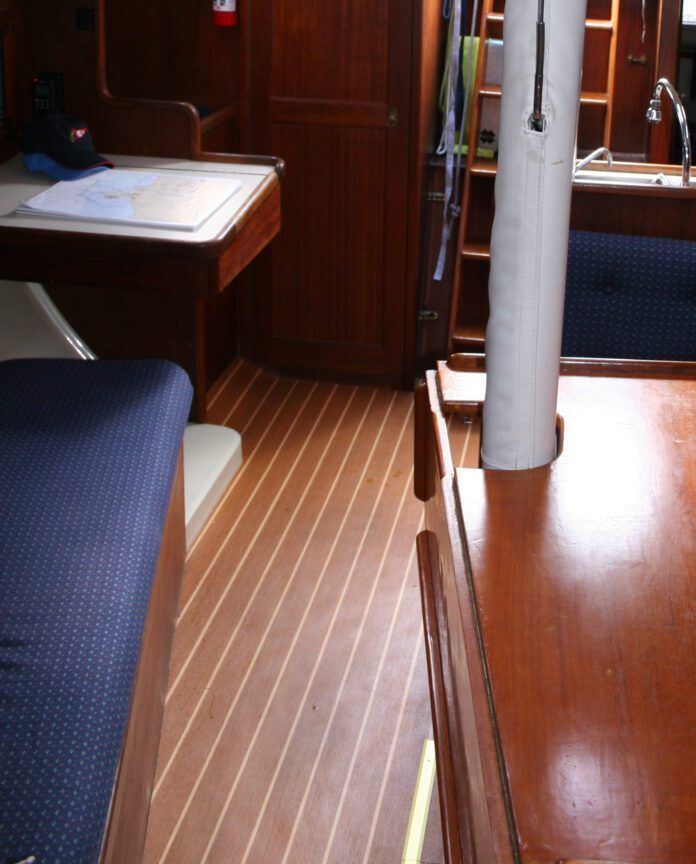The challenge with finishing a veneer-and-plywood sole is finding a product that offers long-lasting protection for the wood and gives a secure footing when the cabin sole is wet. Varnishes suitable for protection and durability do not have intrinsically good nonskid characteristics.
Faced with this dilemma, we recommend using a satin-finish, one-part polyurethane varnish to protect the thin veneer and plywood, and adding some nonskid aggregate to the final coats to reduce the slippery-when-wet effect. If you don’t want to use the aggregate on the whole sole, at least add it in when finishing the areas at the base of the companionway and outside the head, where a sole is most likely to get wet.
For brush-on applications, PS editors have had good luck with Interlux’s polyurethane Goldspar Satin, Pettit’s Z-Spar Captains 2067 (clear) or 1015 (amber), and Epifanes High Gloss. The products also have scored well in past Practical Sailor varnish tests for weathering outdoors, so they should have an even longer life in a cabin.
Wood-finish makers echoed our recommendations, and advised that if you opt to go with a high-gloss varnish like the Epifanes High Gloss or Interlux Schooner, be sure to use a flattening agent with it, or, in the case of Epifanes, replace the two final coats with the company’s Rubbed Effect Interior Varnish. Having a satin or matte finish helps to minimize slipping.
According to Interlux, Cetol products can be used on soles, but in our opinion, the relatively soft coatings will not offer enough protection for veneer, and given the amount of traffic a cabin sole sees, they would not wear well.
For aggregate options, you have a few choices. We recommend using salt or crushed walnut shell powder with varnish, rather than the canned aggregate sold by marine paint makers and often used with deck paints. Others prefer pumice or finely ground sand. Both the walnut shell and salt methods are easy to touch up and re-apply.
You can find ground walnut shell powder at larger boat yards, paint supply companies, and Harbor Freight. To use it: After building up a uniform series of base coats (usually six to eight coats, with the first ones thinned some) and letting it cure, place strips of -inch masking tape over the centerline of the -inch holly strips, and then mix the powder in the final coat of varnish. This results in nonskid stripes that are near in color to the teak, with enough of the sole left glossy to add a warm feel to the cabin. If you plan to add this or any other nonskid material to a finish, be sure to run it by the varnish companys technical crew before applying it.
Adding salt to a varnish finish is a little different. First, build up a good protective base, and allow it to cure completely. Then, mask off the areas to be made nonskid, and lay on a heavy coat of the same finish. Heavily sprinkle it with coarse salt; we use a grinder held 2 to 3 feet above the surface. Start with a light coat, moving back and forth until a uniform coating is obtained. Once the coating dries, rinse away the salt crystals with fresh water. Because its water-soluble, the salt disappears, leaving a surface stippled with tiny indentation where the crystals once were. This offers traction without taking away from the finish.
If you have the luxury of applying the finish with the sole out of the boat, take the opportunity to build up a very good base for protection. The more coats you put on, the better the protection. Also, do a few test patches on scrap veneer with salt and with walnut powder to see which you prefer aesthetically.
Cabin soles are a challenge to re-do. Do a maintenance coat once every year or two to get longer life out of the finish and hopefully avoid a full takedown for many years.






































I’m planning to replace the weathered teak and holly sole with a new one very soon. My approach will be to coat both sides and all edges with West System epoxy followed by three coats of varnish on the sole’s top. Any comments?
Whaf, no mention of Awlwood?
At our boatyard, we use Smith’s Clear Penetrating Epoxy as an initial sealer coat on the substrate before adding any type of finish varnish product. This stuff soaks into the wood, adding a layer of protection and when lightly sanded, allows for excellent adhesion to any of the aforementioned varnishes.
Nice job Son, can’t wait to see the finished shop.
Dad
Whatever is used; I still find it cracks. A boat moves
I have a worn sole that I am thinking of refinishing it. Are there any articles I can source from previous installments of Practical Sailor?